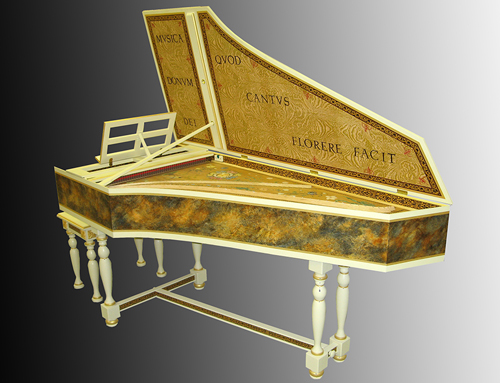
The Harpsichord Project E-book
A Construction Guide for the First Time Builder
Ernest Miller Harpsichords
The Harpsichord Project E-Book 5.2
In the early 1980's when I started building harpsichords, finding instruction on building techniques was very hard to come by.
It still is!
Armed with a strong desire and what little I could find in printed instruction, I built my first instrument. It took
over a year to build - much of that time spent scratching my head trying to decide what to do next, and how to do it.
Nonetheless, it was finally finished and was truly a work of art - or so I thought! True, it only stayed in tune for a few hours
and the touch was so heavy that my pinkies had barely enough strength to play the keys. True, the tone was quite harsh and so
loud that earplugs were necessary for comfortable playing. True, the keys had a nasty habit of slapping against their neighbors
making it sound like I had a drum machine installed in the instrument. True, some of the plectra didn't always pluck their strings
and didn't always return to their rest position when they did pluck. In spite of all of these truisms I was proud, pleased, and happy.
I had built a harpsichord with my own hands and, generally speaking, it worked.
Soon after my masterpiece was completed, I was asked to tune a harpsichord for a concert at a local music conservatory. What an
eye-opening experience that was! Although it hadn't been tuned in quite a while, it was still in tune with itself. The action was
wonderfully easy to play and its sound was powerful and sonorous without the raucous stridency I had become accustomed to on my
instrument. The keys worked flawlessly and the plectra never failed to pluck their strings and return to rest position.
I realized immediately that my "masterpiece" was not all that I thought it was. I resolved to make my next instrument a better one -
but I knew I needed help. My background as a piano technician/rebuilder did not prepare me for the challenges of harpsichord building -
in fact, in several areas of the construction, it hindered me. I was fortunate - I received that help. The builder of the conservatory's
harpsichord, Paul Kennedy, lived in my area and became my mentor and close friend.
And now, some
40 years later, I am meeting (through the miracle of the internet) first time builders who are asking me some of the same questions
I had asked so many years ago. I quickly realized that e-mail correspondence was not the best and most efficient way of sharing
what I have learned with those who are now walking where I once walked. Thus, the Harpsichord Project was born. The goal was to
take an existing instrument, the 1640 Andreas Ruckers single manual harpsichord, and describe in great detail the processes
involved in its construction. The result is an e-book whose 1,122 pages and 1,167 photos and illustrations is,
to the best of my knowledge, the most complete book of its kind ever written on the subject. Every step of the construction
process is described in detail, with photos and/or illustrations to clarify the text. Videos are
included for topics that cannot be adequately described in words. The chapter on Tools and Supplies gives sources for everything
you need to purchase for your build. There is a chapter on Jig Making that gives complete construction details for the various
jigs that are needed. Also included are CAD files from which you can have a full-sized blueprint printed.
In short, if you'd like to build your own harpsichord and don't know where to begin, this is the book for you!

The Harpsichord Project Instrument
Video Summary of the Building Process
Recorded on the Harpsichord Project Instrument